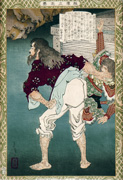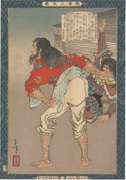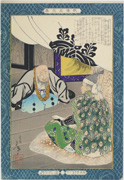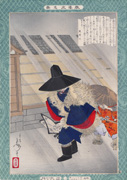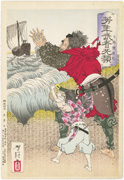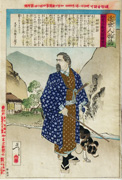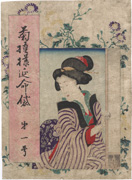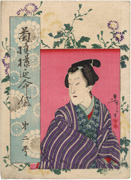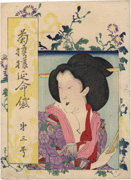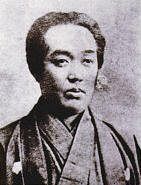Ariko -
Sink Beneath the Waves
from the series
One Hundred Aspects
of the Moon, 1886
IHL Cat. #51
Bon Festival Moon
from the series
One Hundred Aspects
of the Moon, 1887
IHL Cat. #1671The full moon coming with a challenge to flaunt its beautiful brow - Fukami Jikyu
from the series
One Hundred Aspects
of the Moon, 1887
IHL Cat. #43
Kasuga Moon
from the series
One Hundred Aspects
of the Moon, 1888
IHL Cat. #83
from the series
One Hundred Aspects
of the Moon, 1890
IHL Cat. #1670
The Moon's Invention -
Hozo Temple
from the series
One Hundred Aspects
of the Moon, 1891
IHL Cat. #80
-intentionally left blank-
-intentionally left blank-
-intentionally left blank-
Famous Soldiers of Japan, 1878
IHL Cat. #508
Autumn Moon at Tōin, 1884
IHL Cat. #699
IHL Cat. #924
Ikina (first state)
from the series
Instructive Models of Lofty Ambition, October 26, 1885
IHL Cat. #921
Hashiba Hideyoshi
from the series
Instructive Models of Lofty Ambition, December 1885
IHL Cat. #712
-intentionally left blank-
-intentionally left blank-
Soga no Gorō Tokimune and Gosho no Gorōmaru from the series
Yoshitoshi's Courageous Warriors, 1886
IHL Cat. #1829
IHL Cat. #1830
IHL Cat. #1831
Saigo Takamori, No. 17,
from the series
Personalities of Recent Times, 1888
IHL Cat. #926
-intentionally left blank-
-intentionally left blank-
Early Years
Born April 30, 1839 in Edo (the old name for Tokyo) to OwariyaKinzaburō (1815-1863), a merchant who had purchased his samurai status, and aunknown mother, he was named Yonejirō 米次郎 at birth. At an early age,Yonejirō was sent to live with his uncle, a successful pharmacist. In1850, at the age of eleven, his uncle enrolled him as a residentstudent in the school of Utagawa Kuniyoshi (1798-1861), one of the mostsuccessful woodblock print designers in Edo and one of its morecolorful characters. As was customary, Kuniyoshi gave Yonejirō a newname, Yoshitoshi, derived from the second character of Kuniyoshi'sname. Kuniyoshi took a special interest in Yoshitoshi allowing himaccess to his personal collection of foreign prints and engravings.
In 1853, at the age of fourteen, Yoshitoshi composed his first woodblock print - a triptych of the naval battle of Dannoura in which the Minamoto clan destroyed the forces of the Taira clan in 1185. That same year, US Commodore Perry arrived with a fleet of battleships and forced Japan to open its door to the West.
Kuniyoshi's death in 1861, left the 22 year old Yoshitoshistruggling to make a living. In 1863, Yoshitoshi's natural fatherdied.
Yonejiro Becomes Yoshitoshi (芳年)
After his father's death, Yoshitoshi began to sign some of his prints Tsukioka Yoshitoshi,claiming a rather vague relationship between his uncle's family and theTsukioka family, which had produced the eighteenth-century Osakapainter, Tsukioka Settei. In that same year a daughter, who died a year later, wasborn to Yoshitoshi. (The name of Yoshitoshi'swife at that time is unknown.)
Political and Civil Unrest
Yoshitoshi's formative years were lived in a period of greatunrest. The continuing encroachment of Westerners and Western ideasthrough the 1850s and 1860s had a profoundly unsettling effect on afeudal and very closed Japanese society. While popular sentiment wasvery anti-Western there were those who realized that the only defenseagainst the West was to adopt its superior military and economictechnology. The tension between rejecting Western influence andembracing Western technology, coupled with crop failures, economicrecession and hyper-inflation shook the ruling Tokugawa shogunate(which had ruled since 1603) to its foundations. This instability leadto armed conflict between the Tokugawa shogunate (which held power inthe name of the emperor, but exercised independent and almost absolutecontrol over all policy) and competing aristocrats and samurai whowanted to install a more modern government under the guise of restoringthe emperor to his rightful role. This war culminated in the 1868overthrow of the Tokugawa shogunate government and its replacement by amore modern government which proclaimed an imperial restoration and anew era of Meiji ("Enlightened Rule"). Stevenson notes thatthe impact of Yoshitoshi's witnessing the bloody massacre of twothousand shogun troops by the well-armed forces of the emperor at theend of the civil war "reverberated through Yoshitoshi's work for manyyears."
Disturbing Images
Between1866 and 1868 Yoshitoshi produced a number of gruesome and sadisticdesigns in a series called Twenty-eight Murders with Verse. Theseprints, several of which show the stabbing or decapitation of women,were quite popular both in Japan and the West, and sold well. JohnStevenson, in his seminal work, One Hundred Aspects of the Moon, states that "the notoriety of the violence in Yoshitoshi's work is justified to the extentthat he did design shocking images more effectively than any otherprint maker. However, the emphasis that modern critics and galleriesplace on his bloody prints gives a false perspective to his work ...[and] does not give an accurate impression of the subtlety, insight,and integrity of the bulk of Yoshitoshi's designs."
Depression and Resurrection
Atthe time of the Meiji Restoration, Yoshitoshi was achieving a measureof success, with over 240 prints published in 1868 and 1869. Anewspaper ranked him fourth in a list of woodblock print artists andhis name was included in a popular guidebook to Tokyo. However, by themiddle of 1869 his print output slowed to a trickle and did not pick upuntil the end of 1871, although he did maintain his studio and pupils. As Stevenson states, "perhaps Yoshitoshi's inspiration had beenexhausted by the trauma of the recent past."
Towards the end of1871, Yoshitoshi started to received commissions, producing severalseries, but by the next year he had fallen into a deep depression. While he continued to teach, he did not produce prints again until theend of 1872. By the end of 1873 he had worked his way out of hisdepression and produced two triptychs which he signed with a new artistname, Taiso (大蘇) or "Great Resurrection."
The Satsuma Rebellion
In 1877 political events again changed Yoshitoshi's fortunes. With thedismantling of the feudal system, the samurai found their livelihoodand values under attack, with the most egregious attack being the 1876edict prohibiting the wearing of a sword, the quintessential symbol ofthe samurai, by anyone except members of the conscript army. Samurairesentment culminated in the Satsuma Rebellion led by the aristocratSaigo Takamori, a hero to many Japanese who regarded him as a symbol ofthe values of the samurai class. After meeting with initial success,his forces were pushed back by the imperial troops to a hillside nearKagoshima and made a final stand. In this final battle, 60,000government forces faced 40,000 rebels resulting in 16,000 casualtiesfor the government and 20,000 casualties for the rebels. Saigo waswounded and later committed seppuku.
The Satsuma Rebellion provided a boom to newspapers and publisherscommissioned woodblock print artists to design pictures of the events. Yoshitoshi was literally flooded with commissions, designing prints forat least nine different publishers. These prints brought Yoshitoshiboth public recognition and moderate wealth. (See the print Illustration of the Navy Landing at Sukuchi Village in this collection.)
For additional information on prints of the Satsuma Rebellion see the article Satsuma Rebellion Prints on this website.
Newspaper Work
As an additional source of income Yoshitoshi took on newspaper illustration and began creating topical prints for Tokyo's Postal News in early 1875. The demand for his work grow with the popularity of his Satsuma Rebellion prints creating demand from other newspapers for his artwork and around 1880 he began working for Tokyo's Illustrated Liberal Newspaper (E-iri Jyu Shinmbun). Yoshitoshi's salary at the Illustrated started at "a salary of 40 yen a month, a tidy sum in those days, plus transportation to and from the editorial offices in a pedicab bearing the Tsukioka family crest. Later, the stipend was to rise to 100 yen a month, with twenty shares of stock and a jinrikisha into the bargain." His newspaper work paid far more than the typical five or ten yen he would received for even his best designs.
Students
Yoshitoshi's atelier, with more than eighty students, was the major conduit through which training in the ukiyo-e style was passed to the next generation. One of his most famous students was his adopted son Kōgyo who was to become the artist Tsukioka Kōgyo (1869-1927).
The young Kōgyo studied with Yoshitoshi as did many other young, and some older, aspiring artists. A stone monument erected to Yoshitoshi's memory in 1889 lists fifty-nine students and Stevenson cites a source claiming that Yoshitoshi taught over two hundred students during his lifetime. In addition to his adopted son Tsukioka Kōgyo, other well-known artists he taught include Takeuchi Keishū (1861-1942), Migata Toshihide (1863-1925), Goto Toshikage (act. c. 1868-1892), who created a memorial portrait of his teacher inscribed with Yoshitoshi's death poem (see below), and Mizuno Toshikata (1866-1908), who Yoshitoshi designated to succeed him. Lesser known students include Kobayashi Toshimitsu (active 1876–1904), Yamazaki Toshinobu (1857-1886) and Yamada Toshitada (1868-1934) who are represented in this collection.
Later Years and His Death
Yoshitoshi's last years were among his most productive during which his great series One Hundred Aspects of the Moon (1885–1892) and New Forms of Thirty-Six Ghosts (1889–1892), as well as some masterful triptychs of kabuki theater actors and scenes, were produced.
During this period he also cooperated with his friends, the actorDanjuro and others, in an attempt to preserve some of the traditionalJapanese arts.
In his last years, his mental problems started to recur. In early1891 he invited friends to a gathering of artists that did not actuallyexist. His physical conditionalso deteriorated, and his misfortune was compounded when all of hismoney was stolen in a robbery of his home. After more symptoms, he wasadmitted to a mental hospital. He eventually left the hospital in May 1892, but didnot return home, instead renting rooms.
He died three weeks later in a rented room, on June 9, 1892, from acerebral hemorrhage. He was 53 years old. A stone memorial monument toYoshitoshi was built in Higashi-okubo, Tokyo, in 1898.
yo o tsumete
terimasarishi wa
natsu no tsuki
holding back the night
with its increasing brilliance
the summer moon
-- Yoshitoshi's death poem
Retrospective Observations
During his life Yoshitoshi produced many series of prints, and a largenumber of triptychs, many of great merit. Two of his three best-knownseries, the One Hundred Aspects of the Moon and New Forms of Thirty-Six Ghosts, contain numerous masterpieces. The third, Thirty-Two Aspects of Customs and Manners,was for many years the most highly regarded of his work, but does notnow have that same status. Other less-common series also contain manyfine prints, including Famous Generals of Japan, A Collection of Desires, New Selection of Eastern Brocade Pictures, and Lives of Modern People.
While demand for his prints continued for a few years, eventuallyinterest in him waned, both in Japan and around the world. Thecanonical view in this period was that the generation of Hiroshige (1797-1858) wasreally the last of the great woodblock artists, and more traditionalcollectors stopped even earlier, at the generation of Utamaro (1753-1806) andToyokuni (1769-1825.)
However, starting in the 1970s, interest in him resumed, andreappraisal of his work has shown the quality, originality and geniusof the best of it, and the degree to which he succeeded in keeping thebest of the old Japanese woodblock print, while pushing the fieldforward by incorporating both new ideas from the West, as well as hisown innovations.
The Importance of Yoshitoshi’s Prints
Source: The Importance of Yoshitsohi's Prints, John Stevenson, appearing in Beauty and Violence: Japanese Prints by Yoshitoshi 1839-1892, Eric van den Ing and Robert Schaap, Society for Japanese Arts, 1992
Yoshitoshi gave people something new even as he presented them with images of history. He was on the cutting edge of Japan’s struggle to adapt to the modern world even as he portrayed the old, which he turned into the universal.
Print Series
- One Hundred Stories of Japan and China (1865–1866)
- Biographies of Modern Men (1865–1866)
- Twenty-Eight Famous Murders with Verses (1866–1869)
- One Hundred Warriors (1868–1869)
- Biographies of Drunken Valiant Tigers (1874)
- Mirror of Beauties Past and Present (1876)
- Famous Generals of Japan (1876–1882)
- A Collection of Desires (1877)
- Eight Elements of Honor (1878)
- Twenty-Four Hours with the Courtesans of Shimbashi and Yanagibashi (1880)
- Comic Pictures of Famous Places in the Early Days of Tokyo (1881)
- Warriors Trembling with Courage (1883–1886)
- Yoshitoshi Manga (1885–1887)
- One Hundred Aspects of the Moon (1885–1892)
- Personalities of Recent Times (1886–1888)
- Thirty-Two Aspects of Customs and Manners (1888)
- New Forms of Thirty-Six Ghosts (1889–1892)
Other Names
Seals
Signatures - A Few Examples
 Ikkaisai Yoshitoshi ga from the series A Modern Journey to the West, 1864-65 |  一魁斎芳年筆 Ikkaisai Yoshitoshi hitsu with Yositoshi seal from the series Tale of the Forty-Seven Rōnin, 1860 |  Ikkaisai Yoshitoshi hitsu from the series Strong Heroes of the Water Margin, 1868 |  一魁斎芳年圖 Ikkaisai Yoshitoshi zu with paulownia (kiri) leaf seal from the seriesA Theater Alphabet of True Forms, 1869 |  Ikkaisai Yoshitoshi zu with paulownia (kiri) leaf seal |  Gyokuō Yoshitoshi hitsu from the series A Celebration of Gallantry, 1865 |
 玉桜芳年筆 Modern Celebrities of the East, 1860Gyokuō Yoshitoshi hitsu from the series |  ōju Gyokuō Yoshitoshi hitsu |  芳年画 Yoshitoshi gawith Yoshitoshi seal from 1890 triptych |  Yoshitoshi with Yoshitoshi seal from the series One Hundred Aspects of the Moon, 1885-1891 |  Yoshitoshi with Taiso seal from the series One Hundred Aspects of the Moon, 1885-1891 |  應需芳年画 Ōju Yoshitoshi ga with Yoshitoshi seal, 1884 |
 Yoshitoshi hitsu |  ōju? Yoshitoshi hitsu |  ōju Yoshitoshi ga from the series Twenty-Four Hours at Shinbashi and Yanagibashi, 1880 |
 大蘇芳年写 Taiso Yoshitoshi sha with Taiso and Yoshitoshi seals |  ōju Yoshitoshi ga with Yoshitoshi seal from the series Mirror of Beauties Past and Present, 1875-1876 |  応需大蘇芳年 ōju Taiso Yoshitoshi hitsu from Illustration of the Navy Landing at Sukuchi Village, 1877 |  ōju Taiso Yoshitoshi |  ōju Taiso Yoshitoshi with Yoshitoshi seal |  ōju Yoshitoshi hitsu from the series Barometer of Emotion, 1876-1877 |
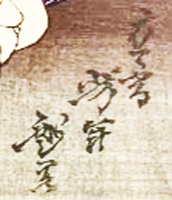 ōju Yoshitoshi giga | 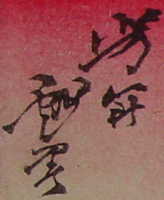 Yoshitoshi giga from the series Comic Pictures of Famous Places Amid the Civilization of Tōkyō,1881 |  芳年戯画 Yoshitoshi giga from the series The Battle of the Cats and Mice, 1859 | 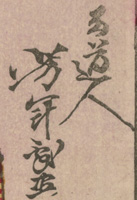 両道人芳年戯画 Ryōdōjin Yoshitoshi giga [Ryōdōjin - a person who knows both ways]from the series Moral Lessons through Pictures of Good and Evil, 1880 |
Links
last revision:
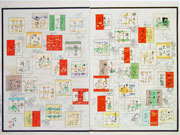
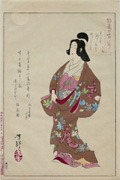
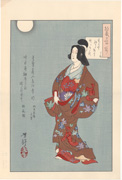
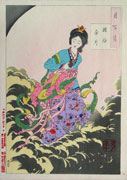
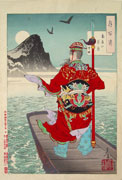
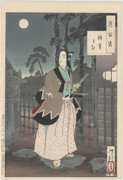
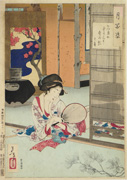
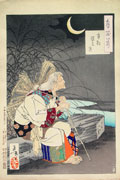
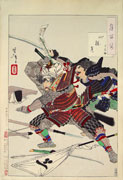


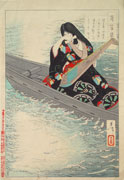
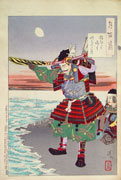
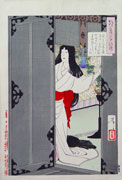
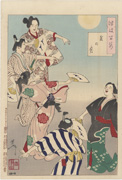
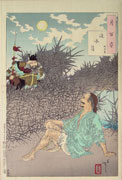

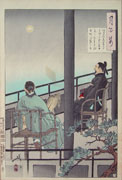
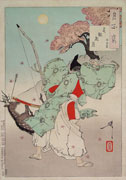

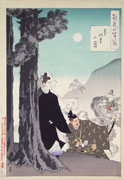
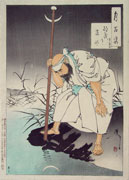



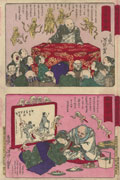
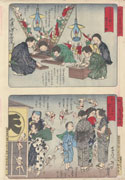

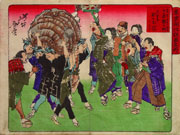
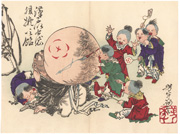
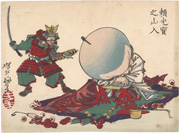
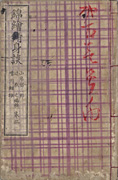
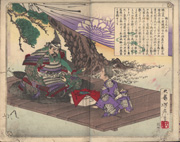
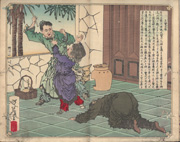
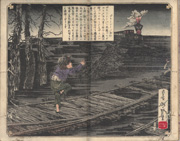
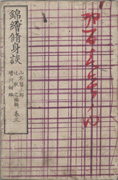
.jpg)
.jpg)
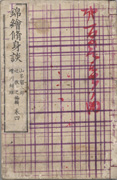
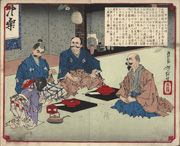

![The Teachings of the Mother of Mencius [A Lesson Drawn from Weaving] from the illustrated textbook Nishikie Shūshindan, Volume 1](yoshitoshi-tsukioka-1839---1892-/The Teachings of the Mother o-42377b8cdf20746c.jpg)
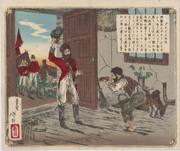
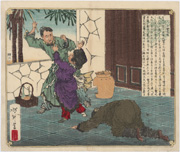

![The Wisdom of Gassendi [Proving that the Clouds Move, Not the Moon]](yoshitoshi-tsukioka-1839---1892-/Brocade Pictures for Moral Ed-f0acbdedc77c7661.jpg)
![The Wisdom of Gassendi [Proving that the Clouds Move, Not the Moon] from the illustrated textbook Nishikie Shūshindan, Volume 4](yoshitoshi-tsukioka-1839---1892-/The Wisdom of Gasenji ihl cat 1304 thumb web.jpg)
